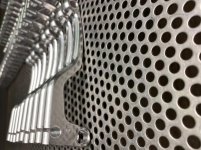Wick Craft
Aluminum
- Joined
- Dec 27, 2013
- Location
- South Charleston, WV
Hello All,
We have been tumbling a large quantity of 6061 parts recently in which dealing with the wastewater has become quite the PITA. In doing some research, it seems I have been looking at two options: configure a large tank for batch operations using some sort of flocculant (RM-10), or possibly adapting a centrifuge of some sort. Currently, I am leaning toward the centrifuge as I could place the machine downstream of the tumblers and have the clean water routed back to the water/compound tank (a sort of closed loop system).
I have been looking at the centrifuge product/design that the WVO guys use for filtering and making biodiesel (basket style). Here is an example:
Extreme Raw Power Centrifuge
Extreme Raw Power Centrifuge | Overview & Operation | Utah Biodiesel Supply - YouTube
An example of one being used to clean water at a truck wash:
Centrifuge for Truck Wash waste water - YouTube
Material: 6061
Deburring process: Plastic pyramids, porcelain balls, then Walnut w/red rouge (dry).
My question is, has anyone used this type of centrifuge for this purpose? Would it even work? How are your results? Comments/concerns? My main goal is to eliminate most of the suspended solids. I realize removing small-to-sub micron particles may be impossible. Hoping to improve water lifespan/quality/efficiency.
Thanks in advance for all your help!
We have been tumbling a large quantity of 6061 parts recently in which dealing with the wastewater has become quite the PITA. In doing some research, it seems I have been looking at two options: configure a large tank for batch operations using some sort of flocculant (RM-10), or possibly adapting a centrifuge of some sort. Currently, I am leaning toward the centrifuge as I could place the machine downstream of the tumblers and have the clean water routed back to the water/compound tank (a sort of closed loop system).
I have been looking at the centrifuge product/design that the WVO guys use for filtering and making biodiesel (basket style). Here is an example:
Extreme Raw Power Centrifuge
Extreme Raw Power Centrifuge | Overview & Operation | Utah Biodiesel Supply - YouTube
An example of one being used to clean water at a truck wash:
Centrifuge for Truck Wash waste water - YouTube
Material: 6061
Deburring process: Plastic pyramids, porcelain balls, then Walnut w/red rouge (dry).
My question is, has anyone used this type of centrifuge for this purpose? Would it even work? How are your results? Comments/concerns? My main goal is to eliminate most of the suspended solids. I realize removing small-to-sub micron particles may be impossible. Hoping to improve water lifespan/quality/efficiency.
Thanks in advance for all your help!






